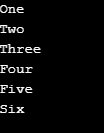
It was first introduced in java 8. A functional interface can be defined as an interface with a single abstract method. This means functional interfaces in java provide only a single basic functionality. However, a functional interface can contain static and default methods, in addition to a single abstract method. java.util.function.Function, java.util.function.Predicate, UnaryOperator, BinaryOperator, Supplier, Consumer are examples of built-in functional interfaces in java.
Start Your Free Software Development Course
Web development, programming languages, Software testing & others
Here is a basic syntax is given below:
public interface MyFunctionalInterface(){
// abstract method
public void functionalMethod();
}From the above syntax, we can see that the interface named MyFunctionalInterface contains only a single unimplemented method; that’s why it can be considered as a functional interface. It can also contain static and default methods like the one shown below:
public interface MyFunctionalInterface(){
public default void defaultMethod(){
// default method logic goes here
}
public static void staticMethod(){
// static method logic goes here
}
// abstract method
public void functionalMethod();
}Also, a functional interface can be implemented using Lambda expression like the following:
MyFunctionalInterface functionalInterface = () ->{
// basic functionality logic goes here
}We can also use an annotation or declaring an interface as a functional interface. Here is how a functional interface can be declared using an annotation:
MyFunctionalInterface functionalInterface = () ->{
// basic functionality logic goes here
}@FunctionalInterface was introduced in java 8 and is used for compiler level error in case an interface breaks rules of a functional interface. Declaring an interface using @FunctionalInterface annotation makes an interface functional, and if more than one abstract method is used, it will generate a compilation error.
Here are some important points :
Example:
@FunctionalInterface
public interface MyFunctionalInterface(){
// abstract method
public void functionalMethod();
@Override
public boolean equals(Object object);
//method overridden from parent class
}Since the above interface overrides a method from the parent class and does not declare multiple abstract methods, it can be considered as a functional interface.
Now we will see java code examples showing declaration and usage of the java functional interface.
In this example, we will show how built-in function interface java.util.function.function interface is used. Here is the declaration of the Function interface.
Interface:
package java.util.function;
public interface Function<T,R>{
public <R> apply(T inputparams);
}In order to use the above interface, we need to implement it in our class like the following.
Code:
import java.util.function.*;
public class FunctionalInterfaceDemo implements Function<Integer, Integer>{
@Override
public Integer apply (Integer n){
return n*n;
}
public static void main (String args[]){
FunctionalInterfaceDemo demo = new FunctionalInterfaceDemo ();
Integer sqroot= demo.apply(12);
System.out.println("Square root of 12 is " + sqroot);
}
}Output:

In this example, we will see how these interfaces are created using lambda expressions.
Code:
public class FunctionalInterfaceDemo{
public static void main (String args[]){
// creating functional Interface instance
Runnable r = () -> {System.out.println ("Executing Thread........");};
new Thread(r).start();
}
}Output:

In this example, we will see the use of another built-in interface consumer to iterate a List.
Code:
import java.util.function.*;
import java.util.*;
public class FunctionalInterfaceDemo{
public static void main (String args[]){
List<String> list = new ArrayList<String>();
list.add("One");
list.add("Two");
list.add("Three");
list.add("Four");
list.add("Five");
list.add("Six");
// Iterate arraylist using consumer
list.forEach(new Consumer<String>(){
@Override
public void accept(String item){
System.out.println(item);
}
});
}
}Output:

The above article gives a clear understanding of functional interfaces in java. The major advantage of using java 8 functional interfaces is support for lambda expressions which removes a lot of boilerplate code, which in turn results in the development of small, efficient, and cleaner code.
The above is the detailed content of Functional Interface in Java. For more information, please follow other related articles on the PHP Chinese website!




